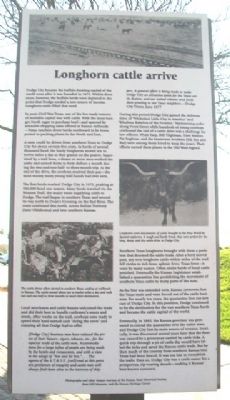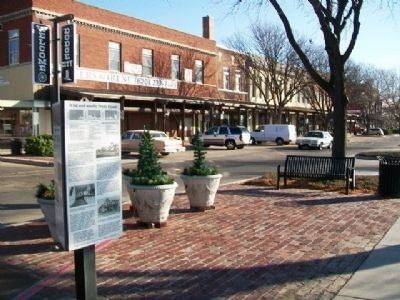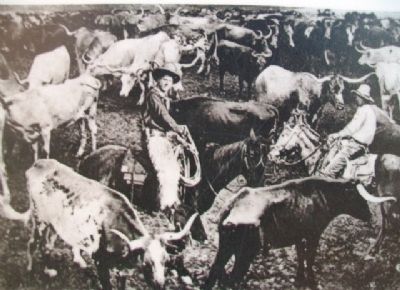Dodge City in Ford County, Kansas — The American Midwest (Upper Plains)
Longhorn cattle arrive
Dodge City became the buffalo-hunting capital of the world soon after it was founded in 1872. Within three years, however, the buffalo herds were depleted to the point that Dodge needed a new source of income. Longhorn cattle filled that need.
In post-Civil War Texas, one of the few ready sources of available capital was wild cattle. With the meat-hungry North eager to purchase beef - and spurred by attractive shipping rates offered at Kansas railheads - Texas ranchers drove herds northward to be transported to packing houses in the North and East.
A steer could be driven from southern Texas to Dodge City for about seventy-five cents. In herds of several thousand head, the hardy longhorns moved ten to twelve miles a day as they grazed on the prairie. Supervised by a trail boss, a dozen or more men worked the cattle and earned thirty to forty dollars a month during the two-and-one-half- to three-month trip. At the end of the drive, the cowboys received their pay - the most money many young trail hands had ever seen.
The first herds reached Dodge City in 1875, peaking at 500,000 head one season. Many herds traveled via the Western Trail, the major route supplying cattle to Dodge. The trail began in southern Texas and wound its way north to Doan's Crossing on the Red River. The route continued due north, across Indian Territory (later Oklahoma) and into southern Kansas.
Local merchants and cattle buyers welcomed the trade and did their best to handle cattlemen's wants and needs. After weeks on the trail, cowboys were ready to spend their hard-earned cash "doing the town" and enjoying all that Dodge had to offer.
[Dodge City] business men have reduced the prices of their liquors, cigars, tobacco, etc., for the especial trade of the cattle men. Accommodations for a large influx of people are being made by the hotels and restaurants, and with a view to the adage "live and let live"...The agents of the A.T.&S.F. [rail]road at this point are gentlemen of integrity and cattle men will always find them alive to the interests of shippers. A general effort is being made to make Dodge City an attractive point for the Texas cattle dealers, and our united citizens send forth their greeting to our Texas neighbors.
- Dodge City Times, June 1877
During this period Dodge City gained the dubious titles of "Wickedest Little City in America" and "Bibulous Babylon of the Frontier." Maintaining order along Front Street while hundreds of young cowboys celebrated the end of a cattle drive was a challenge for law officers. Wyatt Earp, Bill Tilghman, Dave Mather, Pat Sughrue, and the Masterson brothers (Ed, Jim and Bat) were among those hired to keep the peace. Their
efforts earned them places in the Old West Legend.
Southern Texas longhorns brought with them a problem that doomed the cattle trade. After a herd moved past, any non-longhorn cattle within miles of the trail fell victim to tick fever, splenic fever, Texas fever - it went by many names. Often entire herds of local cattle perished. Eventually the Kansas Legislature established a quarantine line prohibiting the movement of southern Texas cattle to many parts of the state.
As the line was extended west, Kansas cowtowns lost the Texas trade and were forced out of the cattle business. For nearly ten years, the quarantine line ran just east of Dodge City. In this position, Dodge continued to be the destination for the vast southern Texas herds and became the cattle capital of the world.
Eventually, in 1885, the Kansas governor was pressured to extend the quarantine over the entire state, and Dodge City lost its main source of revenue. Ironically, it was discovered several years later that the fever was caused by a protozoan carried by cattle ticks. A quick trip through a pit of cattle dip would have killed the ticks and saved the Kansas cattle trade. But by then much of the country from southern Kansas into Texas had been fenced. It was too late to reestablish the trails. Even so, Dodge City was a cattle center for a prosperous, rip-roaring decade - making
it Kansas' best-known cowtown.
Topics. This historical marker is listed in these topic lists: Animals • Industry & Commerce • Railroads & Streetcars • Settlements & Settlers. A significant historical date for this entry is June 9, 1877.
Location. 37° 45.177′ N, 100° 1.153′ W. Marker is in Dodge City, Kansas, in Ford County. Marker is at the intersection of Front Street and 2nd Avenue, on the left when traveling west on Front Street. Touch for map. Marker is in this post office area: Dodge City KS 67801, United States of America. Touch for directions.
Other nearby markers. At least 8 other markers are within walking distance of this marker. Wild and woolly Front Street (here, next to this marker); Dodge City, full of excitement (here, next to this marker); El Capitan (a few steps from this marker); Dennis Weaver (a few steps from this marker); Charles Rath (a few steps from this marker); Milburn Stone (within shouting distance of this marker); Gene Barry (within shouting distance of this marker); "Big Nose Kate" (about 400 feet away, measured in a direct line). Touch for a list and map of all markers in Dodge City.
Also see . . .
1. Cattle Towns. Encyclopedia of the Great Plains website entry (Submitted on May 12, 2013, by William Fischer, Jr. of Scranton, Pennsylvania.)
2. A Cowboy in Dodge City, 1882. Eyewitness to History website entry (Submitted on May 12, 2013, by William Fischer, Jr. of Scranton, Pennsylvania.)
3. Kansas Cowtowns. Encyclopedia of Kansas website entry (Submitted on May 12, 2013, by William Fischer, Jr. of Scranton, Pennsylvania.)
4. Longhorn Cattle. Handbook of Texas website entry (Submitted on May 12, 2013, by William Fischer, Jr. of Scranton, Pennsylvania.)
Credits. This page was last revised on February 24, 2022. It was originally submitted on May 12, 2013, by William Fischer, Jr. of Scranton, Pennsylvania. This page has been viewed 891 times since then and 43 times this year. Photos: 1, 2, 3. submitted on May 12, 2013, by William Fischer, Jr. of Scranton, Pennsylvania.


